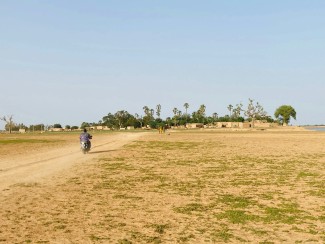|
|
|
|
The trade performance of most least developed countries (LDCs) has traditionally been plagued by persistent deficits and this situation has not been reversed recently
LDC economies have grown stronger than originally expected in the aftermath of the global financial crisis of 2008–2009, and the group achieved a growth rate of almost 5% annually in the 2011–2017 period. This was accompanied by a 2.7% annual expansion of their export revenues (of both goods and services) during that period.
These positive developments were, however, overwhelmed by the much faster expansion of imports. Merchandise import volumes grew more rapidly than exports between 2000 and 2017, expanding by a factor of 3.5, with only a marginal slowdown since 2009. This was spurred by: rapidly growing consumption, especially of goods with a relatively high income elasticity of imports; large investment needs requiring imported capital goods; and demand for imported intermediates in the context of global value chain activities.
Weak trade patterns in spite of positive growth performance
What explains these worrying developments in LDC trade even in the face of strong growth performance? It is the weak development of productive capacities and the failure of these economic to achieve structural transformation towards more modern and higher-productivity activities and sectors.
Consequently LDC exports are highly concentrated on commodities and low value-added manufactures (especially garments). Commodities accounted for over 57 percent of the group’s total merchandise exports over 2015–2017. The positive growth performance of LDC exports in recent years was accompanied by only very limited diversification or upgrading of their export baskets. Equally, the fact that economic growth results in strongly rising imports lingers.
This generally weak performance of LDC foreign trade is largely responsible for negative results in these countries’ current account (which also includes remittances apart from foreign trade).
Half of LDCs experienced persistent current account deficits in 2002–2017. Even among the remaining LDCs deficits remained the rule, as they recorded surpluses only sporadically. The only LDCs which consistently achieved a surplus in their current account were some large commodity exporters (such as Angola, Democratic Republic of the Congo and Timor-Leste) or countries where persistent trade deficits have been more than compensated by large inflows of workers’ remittances (for example Bangladesh, Lesotho, Nepal).
Moreover, the current account deficits of LDC have been expanding. While the group of LDCs had achieved a small surplus of US$2 billion in 2006–2007—just before the outbreak of the financial crisis— this has since turned into growing deficits, which reached US$52 billion in 2016–2017. The widening of current account deficits in the post-crisis period is generalised among LDCs and the current account imbalances will likely persist—and possibly widen—over the medium term.
Current account deficits need to be financed externally
The current accounts deficits of most LDCs are the flipside of the shortfall of domestic savings as compared with the investment needs of LDCs. The latter are enormous and have been growing as these countries pursue the Sustainable Development Goals (SDGs).
Domestic resource mobilisation on a scale commensurate with the huge investment needs of LDCs is not an option for them, due to their low income and high levels of poverty. Current account deficits need to be financed by foreign capital inflows, hence LDCs’ external financing needs and their dependence on foreign savings.
The main sources of external finance have traditionally been foreign direct investment, traditional official development assistance, resources arising from South–South cooperation, remittances, external debt and portfolio investments.
Given the weak state of development of their productive capacities and their failure to achieve structural transformation, LDCs have little ability to attract market-based forms of sustainable long-term financing. Therefore, the major source of external development finance for LDCs as a group is official development assistance (ODA), and the vast majority of these countries are dependent on ODA for their development finance.
Dependence on ODA brings several challenges to LDCs in the pursuit of their development goals. By contrast, for other developing countries, foreign direct investment is the most important source.
Largest sources of external finances for least developed countries, 2017
Source: UNCTAD
Increasingly, LDC current account deficits are financed by debt instruments, such as ODA and commercial loans. Therefore, the foreign debt of these countries has been expanding in tandem with their widening current account deficits. The total stock of external debt for LDCs more than doubled between 2007 and 2017, from US$146 billion to US$313 billion.
The debt situation has deteriorated for several LDCs, to the point that it has become unsustainable or at the risk of becoming so for several LDCs. At present, of the 46 LDCs evaluated for their debt sustainability, 5 are in debt distress and 13 more are classified at high risk of debt distress. Equally worrying is that most of these LDCs had received debt relief only 10–15 years earlier, under the Heavily Indebted Poor Countries Initiative or the Multilateral Debt Relief Initiative.
The goal is to eventually overcome aid dependence
In the medium to long term, LDCs need to overcome their dependence on ODA and increasingly resort to other sources of development finance, such as commercial finance. Successfully mobilising external finance will allow LDCs to boost the development of their productive capacities and achieve the structural transformation of their economies.
LDCs need to carefully manage ODA in the short run and, in the long run, overcome dependence on ODA for the financing of their development. This requires a carefully designed and implemented strategy for financing for their development.
------
A more detailed analysis of LDC’s external performance and of their dependence on external financing, as well as policies and strategies to overcome their present challenges is available in UNCTAD’s report The Least Developed Countries Report 2019: The Present and Future of External Development Finance – Old Dependence, New Challenges, available from 19 November 2019.
-----
Rolf Traeger is Chief, LDC Section, at the United Nations Conference on Trade and Development (UNCTAD).
Header image: Bagged soybeans in Malawi. ©Ollivier Girard/EIF
If you would like to reuse any material published here, please let us know by sending an email to EIF Communications: eifcommunications@wto.org.




